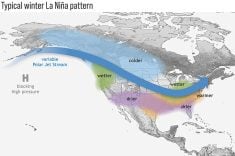When the United States was challenged at a July meeting of the World Trade Organization agriculture committee over its return to dairy export subsidies, it had a simple explanation.
Other countries made us do it.
“Replying to concerns from China and New Zealand, the U.S. said it was forced to reintroduce export subsidies on dairy products in May because other countries’ subsidies were depressing prices and making the U.S. industry uncompetitive,” said a July 7 report from the WTO agriculture committee.
In Ottawa, Dairy Farmers of Canada executive secretary Richard Doyle was dismissive of the American explanation.
Read Also

Canadian Food Inspection Agency extends chronic wasting disease control program consultation deadline
Date extended for consultation period of changes to CWD program
“It is just an excuse,” he said. “Basically, the Americans are saying they had to move because earlier the European Union reintroduced subsidies. I think even if the EU had not moved, the United States would have.”
When the New Zealand representative at the meeting asked when the export subsidies would end, there was no definitive answer.
Doyle said the U.S. resumed its policy of using the government’s Commodity Credit Corp. to purchase surplus butter, skim milk powder and cheese from the market because of a domestic problem.
It wants to support depressed domestic prices by removing surplus product that was created because U.S. milk production has not shrunk sufficiently in response to a collapse in world prices and a reduction in world trade in dairy products.
While some surplus cheese is disposed of through food stamp and school feeding programs, butter and powder typically are exported.
With the relaunch of export subsidies, the U.S. hopes to dump some of its growing stocks on world markets.
The EU restarted its dairy export subsidies last winter.
It typically holds 25 percent of world dairy trade, with New Zealand the largest exporter followed by Australia with 10 percent of the market and the U.S. with nine.
Doyle said subsidies are creeping back into the industry because it is in crisis worldwide as prices fall sharply.
“Right now, it is a disaster in Europe, and the U.S. isn’t doing any better,” he said. “Milk prices now are at 1979 levels and I don’t know of anyone who could get by making what they made in 1979.”
U.S. milk prices have been cut in half in the past year.
However, the Chinese delegate in Geneva was not impressed by the American explanation, according to an official account of the agriculture committee meeting published by the WTO.
“China said the U.S. should get together with other countries to fight the subsidies instead of using them,” said the WTO report.
“In its complaint, it had described the U.S. move as ‘very beggar-my-neighbour’ behaviour.”














